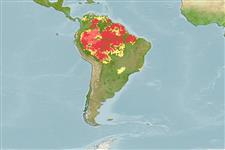| Native range | All suitable habitat |

|
| This map was computer-generated and has not yet been reviewed. |
| Pseudoplatystoma fasciatum AquaMaps Data sources: GBIF OBIS |
Issue
Considered as species inquirenda by some authors. Junior synonym Platystoma punctifer (Buitrago-Suárez, 2006:120) is considered valid by Buitrago-Suárez & Burr, 2007 (Ref. 59362). This species record will be modified.
Length at first maturity
Lm ?, range 53 - ? cm
Human uses
Fisheries: commercial; gamefish: yes; aquarium: public aquariums
Phylogenetic diversity index
(Ref. 82805)
PD50 = 0.5078 many relatives (e.g. carps) 0.5 - 2.0 few relatives (e.g. lungfishes)
Trophic Level
(Ref. 69278)
4.4 ±0.78 se; Based on food items.
Resilience
(Ref. 69278)
Medium, minimum population doubling time 1.4 - 4.4 years (K=0.31-0.47; tm=3-5; Tmax=8.7)